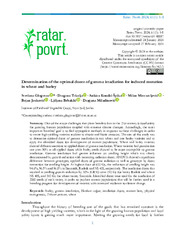Determination of the optimal doses of gamma irradiation for induced mutation in wheat and barley
Određivanje optimalnih doza gama zračenja kod indukovanih mutacija pšenice i ječma
| dc.creator | Glogovac, Svetlana | |
| dc.creator | Trkulja, Dragana | |
| dc.creator | Kondić-Špika, Ankica | |
| dc.creator | Mirosavljević, Milan | |
| dc.creator | Jocković, Bojan | |
| dc.creator | Brbaklić, Ljiljana | |
| dc.creator | Miladinović, Dragana | |
| dc.date.accessioned | 2024-04-18T10:40:59Z | |
| dc.date.available | 2024-04-18T10:40:59Z | |
| dc.date.issued | 2024 | |
| dc.identifier.issn | 2217-8392 | |
| dc.identifier.uri | http://fiver.ifvcns.rs/handle/123456789/4496 | |
| dc.description.abstract | One of the major challenges that plant breeders face in the 21st century is food safety for growing human population coupled with extreme climate changes. Accordingly, the most important breeders’ goal is to find appropriate methods in response to these challenges in order to create high-yielding varieties resilient to abiotic and biotic stressors. The aim of this study was to determine optimal doses of gamma irradiation in two wheat and one barley varieties and to apply the identified doses for development of mutant populations. Wheat and barley varieties showed different reactions to applied doses of gamma irradiation. Wheat varieties had germination rate over 90% at all applied doses while barley seeds showed to be more susceptible to gamma irradiation. Gamma irradiation had greater influence on seedling height which was clearly demonstrated by growth reduction with increasing radiation doses. ANOVA showed a significant difference between genotypes, applied doses of gamma radiation as well as genotype by doses interaction for seedling height. At highest dose of 600 Gy, the reduction of seedling height was 94.6%, 96.5% and 96.8% in Simonida, Rudnik and NS 40S, respectively. The irradiation doses that resulted in seedling growth reduction by 50% (GR50) were 210 Gy for barley Rudnik and wheat NS 40S, and 310 Gy for wheat variety Simonida. Identified doses were used for the irradiation of 2000 seeds of each variety in order to produce mutant populations that will be further used in a breeding program for development of varieties with increased resilience to climate change. | sr |
| dc.description.abstract | Jedan od najvećih izazova za oplemenjivače u 21. veku je da se osigura dovoljna količina hrane za rastuću ljudsku populaciju u ekstremnim vremenskim uslovima izazvanim klimatskim promenama. Shodno tome, najvažniji cilj za proces oplemenjivanja je pronalaženje odgovarajućih metoda za stvaranje visokoprinosnih sorti tolerantnih na abiotičke i biotičke faktore stresa. Cilj ovog istraživanja bio je da se utvrde optimalne doze gama zračenja za dve sorte pšenice i jednu sortu ječma i da se identifikovane doze primene za razvoj mutantnih populacija. Sorte pšenice i ječma su ispoljile različite reakcije na primenjene doze gama zračenja. Sorte pšenice su imale klijavost preko 90% pri svim primenjenim dozama, dok je za ječam utvrđena veća osetljivost na gama zračenje. Gama zračenje je imalo veći uticaj na visinu klijanaca, pri čemu je redukcija rasta bila izraženija sa povećanjem doze zračenja. Analiza varijanse (ANOVA) je pokazala značajnu razliku u visini klijanaca između genotipova, primenjenih doza gama zračenja kao i interakcije genotip × doza. Pri najvećoj dozi od 600 Gy smanjenje visine klijanaca iznosilo je 94,6%, 96,5% i 96,8% kod Simonide, Rudnika i NS 40S, redom. Doze zračenja pri kojima je redukcija rasta klijanaca bila 50% (GR50) iznosile su 210 Gy za sorte Rudnik i NS 40S dok je za sortu pšenice Simonida bila 310 Gy. Identifikovanim dozama je zračeno 2000 semena svake sorte za proizvodnju mutantnih populacija koje bi se u budućim programima oplemenjivanja mogle koristiti za stvaranje sorti tolerantnih na izmenjene klimatske uslove. | sr |
| dc.language.iso | en | sr |
| dc.publisher | Novi Sad : Institute of Field and Vegetable Crops | sr |
| dc.relation | info:eu-repo/grantAgreement/MESTD/inst-2020/200032/RS// | sr |
| dc.relation | IAEA project RER5024: Enhancing Productivity and Resilience to Climate Change of Major Food Crops in Europe and Central Asia | sr |
| dc.relation | Climate Crops - Centre of Excellence for Innovations in Breeding of Climate-Resilient Crops, Institute of Field and Vegetable Crops | sr |
| dc.rights | openAccess | sr |
| dc.rights.uri | https://creativecommons.org/licenses/by/4.0/ | |
| dc.source | Ratarstvo i povrtarstvo | sr |
| dc.subject | barley | sr |
| dc.subject | gamma irradiation | sr |
| dc.subject | Hordeum vulgare | sr |
| dc.subject | irradiation doses | sr |
| dc.subject | mutant lines | sr |
| dc.subject | physical mutagenesis | sr |
| dc.subject | Triticum aestivum | sr |
| dc.subject | wheat | sr |
| dc.subject | doze zračenja | sr |
| dc.subject | fizička mutageneza | sr |
| dc.subject | gama zračenje | sr |
| dc.subject | ječam | sr |
| dc.subject | mutantne linije | sr |
| dc.title | Determination of the optimal doses of gamma irradiation for induced mutation in wheat and barley | sr |
| dc.title | Određivanje optimalnih doza gama zračenja kod indukovanih mutacija pšenice i ječma | sr |
| dc.type | article | sr |
| dc.rights.license | BY | sr |
| dc.citation.epage | 8 | |
| dc.citation.issue | 1 | |
| dc.citation.spage | 1 | |
| dc.citation.volume | 61 | |
| dc.identifier.doi | 10.5937/ratpov61-48887 | |
| dc.identifier.fulltext | http://fiver.ifvcns.rs/bitstream/id/11993/bitstream_11993.pdf | |
| dc.type.version | publishedVersion | sr |


